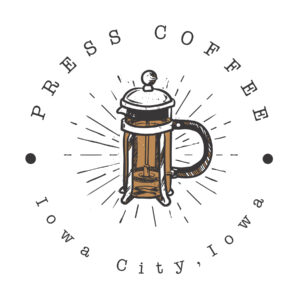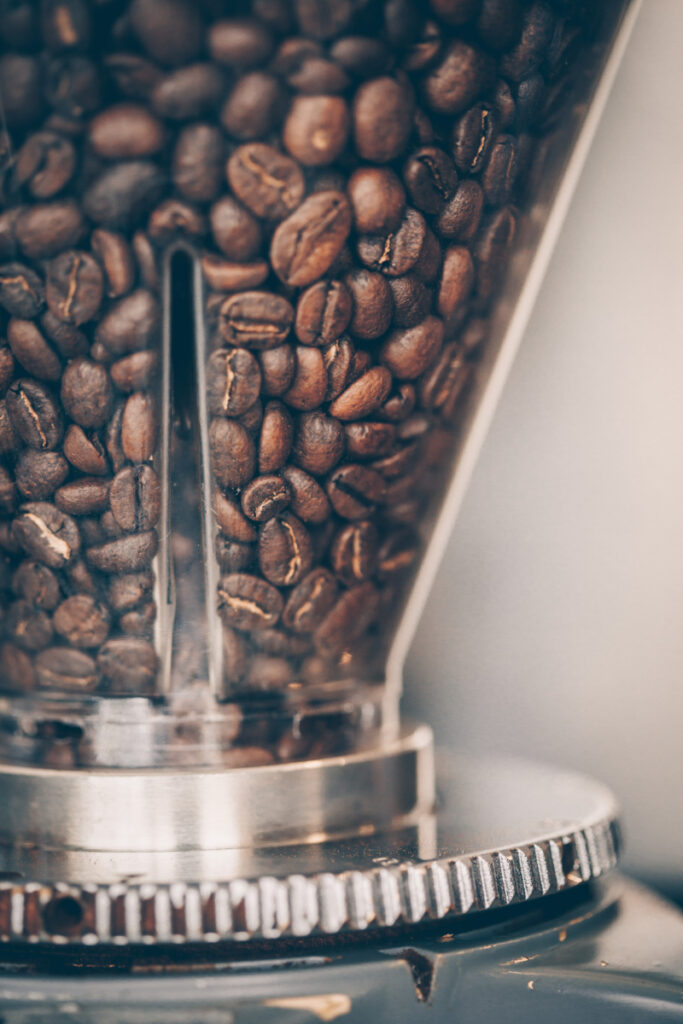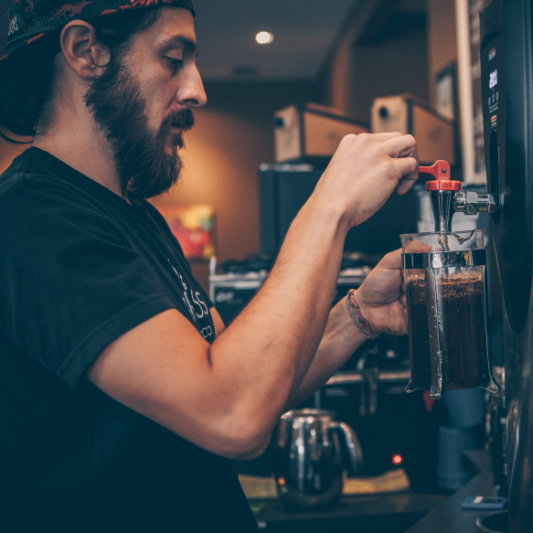A’s for your Q’s: The Grind
- Lisa Edwards
- Feb, 25, 2021
- Answers
- Comments Off on A’s for your Q’s: The Grind
At Press Coffee we not only want you to have the best cup of coffee you can get your hands on, but we want you to understand what makes it so good. If you have questions about coffee or want tips on making your home brewing better, navigate to our contact page to drop your Q’s in the form.
Last week we addressed different coffee alternatives, focusing on caffeine levels and natural energy-boosting ingredients. Today we have answers for: how does grind size affect the taste of coffee?
A lot of elements go into making a delicious cup of coffee. Start with fresh, whole bean coffee, ideally from your favorite local roaster, and grind them just before brewing. Portion your beans using a scale and set the grind to match the brewing method. Aim for a coffee to water ratio of 1:15 and use filtered, 200-degree (F) water. The last factor is the length of time that the coffee is in contact with water, an important factor with the French press method. Think of brewing coffee as a science experiment with multiple variables that can affect whether your coffee comes out good or gross. For now, we will go over the details of coffee grinding.
If the quality of your brew is important to you, then so should be a quality grinder. There are two main options to choose from: blade grinders, which are cheap and less precise, or burr grinders which are more expensive yet consistent. A blade grinder is portable, easy to clean, and available at most department stores for around $15-$30. It works similarly to a food processor in that it has one or two blades that spin and chop. Adjusting the grind just depends on how long you grind the beans. However, imagine putting ice cubes in a blender and trying to chop them to a specific size in uniform pieces. Another side effect of a blade grinder is that the device will produce heat, altering the chemistry of the beans before you even start brewing.
Ideally, you want a burr grinder in your arsenal. If you’re a serious coffee drinker then it’s worth it to spend a little more on a grinder to ensure you end up with a consistent grind size. It is a one-hundred-dollar investment on average, but if you keep your eyes peeled at secondhand stores, you might find a barely used one for $15. (I found CNET’s top grinder of 2021 at Goodwill and saved $85!) Instead of a blade, it has two revolving burrs that are either conical or flat, both having their own pros and cons. Conical is naturally more energy-efficient and heat resistant but could allow some small irregularities in the grind. Flat burrs are very precise and a better option for espresso, but are louder and produce more heat. Either one is much more versatile than a blade and adjusts to the chosen grind size by changing the distance between burrs. And if you’re the type to pick up a manual lawn mower, then you could save some bucks by purchasing a hand coffee grinder.
| Grind Size | Brewing Method | Texture |
| Coarse | French Press, Cold Brew, Coffee Cupping | Sea Salt, Ground Peppercorn |
| Med./Coarse | Chemex, Clever Dripper, Cafe Solo Brewer | Rough Sand |
| Medium | Flat-Bottom Drip Machine, Cone-Shaped Pour-Over, Aeropress – 3+ Min. Brew Time | Regular Sand |
| Med./Fine | Pour-over, Aeropress – 2-3 Min. Brew Time | Sugar |
| Fine | Stove-Top Moka Pot, Aeropress – 1 Min. Brew Time | Table Salt |
| Extra Fine | Espresso, Turkish Ibrik | Flour, Powder |
You got your beans, you got your fancy grinder; the next step is to match grind size to the brewing method. At Press, our grinder is always set to coarse since we brew all our coffee by French Press. This method has the coffee grounds soaking in water for an extended period of time so the grind size can be chunkier. If you are relying on gravity to do the work with a pour-over or drip brewer, then the contact time between coffee and water is much shorter and a finer grind is needed to expose more surface area of the bean for extraction. In an espresso machine, you have the added boost of pressure forcing water through the grounds, lasting 25-30 seconds. It takes very fine, very consistent grounds to produce a good espresso shot. If you have an espresso machine at home, you may want to check out these grinder options, backed by baristas.
General rule of thumb is: less time, more fine
Coffee is full of complex flavor and aromatic compounds that are released once the coffee is ground and added to water. Acids are the first to be extracted and taste intensely sour or even salty. Next, the aromatic oils are extracted, soluble particles are dissolved, and sugars are released to help balance the acids and provide a rich, fuller flavor. Lastly are the bitter flavors. It may sound unappealing, but just like mixed alcohol drinks, a hint of bitterness provides more depth and a well-round drink. With the right balance of tangy acids, sweet sugars, and a few bitter low notes, you can achieve coffee nirvana.
Keep in mind, if you start with the wrong grind size or let it brew too long, you’re going to disrupt the balance of your cup. An under-extracted coffee means that the water isn’t getting enough face time with the bean, drawing out only the first layer of flavor. Over-extraction means the two are spending too much time together, resulting in bitterness. Therefore, if your cup turns out weak or sour, adjust the experiment by either increasing the brew time or using a finer grind size; if it’s bitter, decrease the contact time with water or grind the beans more coarsely.
Everyone’s taste in coffee is different, so feel free to use this information as a guidepost and then tweak your at-home brewing experiments to your liking. Revisit the elements of a good cup of coffee at the top of this page and start making small adjustments until you find what tastes best to you. Record your measurements like a true scientist so you can replicate your results tomorrow.
Learn how to clean your coffee grinder and the rest of your equipment.

Pressing Newsletter
Social
Find us online:
Facebook
Instagram:
@PressCoffee_ic
@PupsofPress
TikTok
Yelp
Order through the Joe Coffee app!



